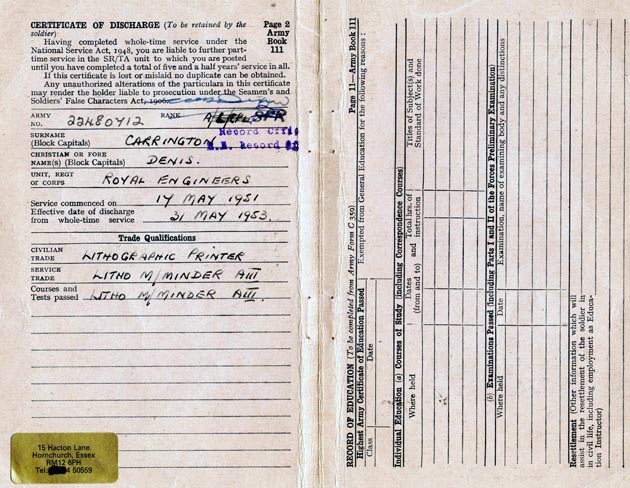
Survey Production Centre - Alperton NW 10
January 1952 - May 1953
Now having successfully completed my ‘A' trade course at the School of Military Survey, my posting to the Survey Production Centre at Park Royal near Wembley, came through just before Christmas 1951,and I was instructed to report there directly after the holiday.
There were I think, two main buildings that comprised the centre. The one in Elveden Place, housed the drawing office and map store, together with the admin offices. The other in Elveden Road contained all the printing presses, plate making, cameras, and ancillary equipment. For the more technically minded, the printing equipment included a battery of four 2 colour double-demi Crabtree offset presses, a demi size 2 colour, and a quad-crown single colour, also made by Crabtree. This together with all the cameras, plate making equipment, and paper store, was quite a large printing plant.
There were I suppose at the time, around 100 or so staff at the plant, producing ordnance survey maps and aerial photographs. The military presence I think , comprised a full colonel in charge, a Major Glue (nick-named ‘Sticky‘!) one lieutenant, latter Capt, one sergeant and two full corporals (all regulars); also around a dozen National Service sappers, one of which was a lance corporal. Plus two R.A.F. men who looked after the map store, these were also National Service men.
Some of the sappers names that come to mind were (see photos) John Carr, whose father owned a large printing works in Leicester. John had a brand new Riley R.M.F. two and a half litre car in green and black livery. Bob Bluck from Watford, who had a shaft driven 500cc Sunbeam motorbike, Alan Jones from Redditch, Brian Haig from Yorkshire, Ken Dallison from London who was a keen jazz fan, and also played piano, and another sapper known as Alvar, who's surname escapes me, as do the names of many others from that time, almost 60 years ago.
Being so under worked at this time, true to army fashion, cards were played most days, and we all became minor experts at the favourite game of ‘hearts' or as some call it ‘Black Bitch'.
Opposite the works in Elveden Road was a factory called Hoopers, who made special bespoke car bodies for Rolls, Daimlers and Bentleys; and also in the past for horse drawn carriages.
As there was no barracks accommodation nearby, all the service personnel were billeted out to nearby families, mainly civilians who worked at the S.P.C. I was fortunate in as much as, my home was just an hour or so away by train and bus, so I was allowed to live at home, and received a living out allowance, a ration allowance, a travelling allowance, and a special London weighting, this together with being promoted to Lance Corporal at a later date, gave me an income of around £7 - not bad for 1952!. In fact I had to take a drop in income when I resumed my apprenticeship back in civvy street.
Early in 1952 I purchased from Bob Bluck his old 1938 B.S.A. 350cc Empire Star motorbike (see receipt) so this made the journey from home to Elveden Road even better. Our next door neighbour at Poplar was Arthur Pryor, and he and his family were the proud owners of a 500c.c.Norton bike with a huge sidecar. He volunteered to teach me to ride; the method Arthur employed was to sit me on the front of the B.S.A. while he climbed on the pillion, and said go, and we went! To return some ten minutes later - me a bag of nerves, and he with somewhat greyer hair than when we started!
One of the civilian employees at the factory was a N.A.T.S.O.P.A. (printing assistant - semi-skilled) called Bill, an old sailor from war time naval service; each day at 12 noon he rang 8 bells on an improvised tubular bell to keep up his naval tradition. Apart from practising our limited skills at lithographic printing, (army fashion,) we did very little in the way of real soldiering. With no parades to attend or guards to mount, we did once or twice visit a .022 indoor rifle range at a T.A. centre in Bethnal Green, and also the outdoor ranges at Purfleet and Rainham Essex, where we were using our Lee Enfield 303's.
Another duty we had to perform during the winter of 1952/3, was when we had to take a large army truck to a rail siding some miles away, and there filled up sacks of coke for the factory's boilers, I believe there had been a transport strike or bad weather, or both at the time. Anyway while the officer and sergeant rode in the dirty old coal truck, we sappers rode with some style in John Carr's posh Riley (see photo).
After a few weeks at the S.P.C. the one National Service N.C.O. finished his 2 years and was demobbed. I was promoted in his stead, and this rank meant I was now responsible as sports N.C.O. for all the recreational training which was, and still is I believe, traditionally held on Wednesday afternoons. As well as running an occasional cricket team during the summer in which a couple of the girls who worked at the S.P.C. played a prominent part, and an equally scratch soccer team in the winter (both heavily supplemented by the civilians at the plant). I did arrange tennis, ice skating, and attending the mid-week internationals at Wembley stadium. One notable game against Wales included such stars as John Charles, Ivor Allchurch and Trevor Ford.
The Guinness brewery was also nearby at Park Royal, and they very kindly allowed us to use their sports ground for some of our home games. The venue was always very popular with both home and away teams, particularly the half-time and after match refreshments!
Also during that summer we entered a tug-of-war team in the London District games, which were held at the sports ground near the Chelsea Pensioners Royal Hospital, I don't think we passed the first round - and still have the scars to prove it!
My one claim to fame during this period, was playing a game against another London army unit, which included at centre forward one Bobby Smith, who was at the time a very promising 18 year old at Chelsea, and later went on to play for Spurs and England. As I was playing centre half at the time, just don't ask me how many goals he scored!
One day in early June 1952, our small unit was transported to Horse Guards Parade ground, there to attend a dress rehearsal of Trooping the Colour, of I think the 2 nd battalion Scots guards, which was due to take place the following week, with our new Queen taking the salute, it was a memorable occasion, with all the pomp and pageantry on display.
Another bonus of being posted in the London area, was we were able to use the Nuffield centre near Charing Cross. This was a club for all service personnel where one could get a decent meal at a low price, and also be given free theatre tickets for many of the West End shows that evening.
As mentioned earlier, I was now living at home and commuting to the S.P.C by motorbike, so it was almost like being back in ‘civvy street'.
And so it was during this period in February 1952 at the South Poplar Youth club ( more commonly known by the acronym S.P.Y.club) attached to All Saints church, that I met the young 'Forfar bridie' Scots lass who was now living in London with her Aunt and Uncle. She had come down from Scotland with them in 1945, after staying with them and other relations, since her Mother died when she was just 5 years old, and her Father was
Serving in the R.A.F. She was looking, for a tall dark and handsome boyfriend and found me,-- so I suppose two out of three wasn't bad!!
She was some four years later to become my wife, making our home in Hornchurch; and now some 54 years, and four children later, I still consider this the best decision I ever made.
During the Easter holiday of that year, my now girlfriend, Betty Russell,(see photo) invited me to go and visit her Father and Stepmother who had a small holding out in the sticks near Hethersgill, which is some 10 miles or so north of Carlisle. Being city dwellers this was to us an attractive change. One morning during our stay, having decided to spend the day in Carlisle, we set off to walk the mile or two into Hethersgill village, there to catch the daily bus, only to see it disappearing into the distance, having missed it by a minute or so.
Standing dejectedly by the village store bus stop, we were hailed by the driver of a little green van and offered a lift into Carlisle. We noticed the words 'Milk Marketing Board' on the side of the van, but didn't pay much attention to it at the time, thinking he was some sort of inspector or the like. He explained he had to make one or two calls at farms on the way, and would we like to come in with him. Upon reaching the first farm we were introduced to the farmer who led the way to the byre. “There they are Jack” he said to our driver, “just three for you today”.
The Marketing Board man then donned a floor length rubber apron, and arm length rubber gloves from his black bag. We thought this a very elaborate procedure for testing milk. Imagine our open-mouthed amazement and embarrassment when he then proceeded to plunge one arm up to the armpit, in the cow's rear end, while the other hand was employed holding a syringe, the size of a bicycle pump with which he then artificially inseminated the beast!
Seeing our startled expressions, he told us he was father to half of the cattle in the area, and was known locally as the 'Bull in the Bowler hat'!
And now in conclusion with my demob date fast approaching during May 1953, I had to decide one of two options. The first was to serve a period of five years in what was then called the Z Reserve, this meant you were liable for instant recall should any emergency demand it. The other option was a three year period in the T.A, which included 2 weeks summer camp, and 2 or 3 weekend gatherings each year. I chose the second option and joined, 135 Survey Engineer Regiment (T.A.) at East Block 'C', Duke of York's H.Q. Chelsea S.W.3. Spending summer camps at Otley Yorkshire and Penhale Cornwall. Also weekends at Chatham, Schorncliff, Ewell, and Lillie Road. But is all this another story? - well maybe!!
Denis Carrington. October 2010

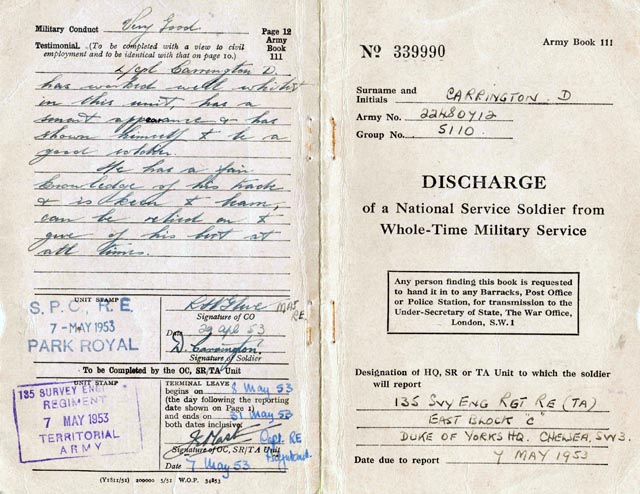
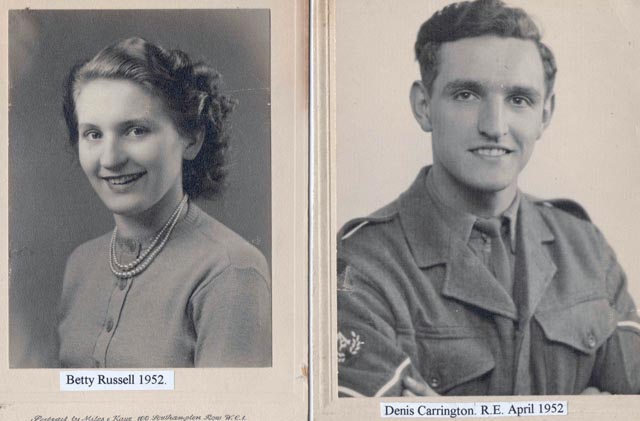

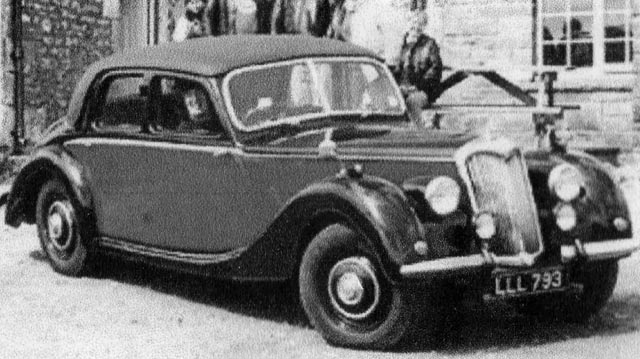
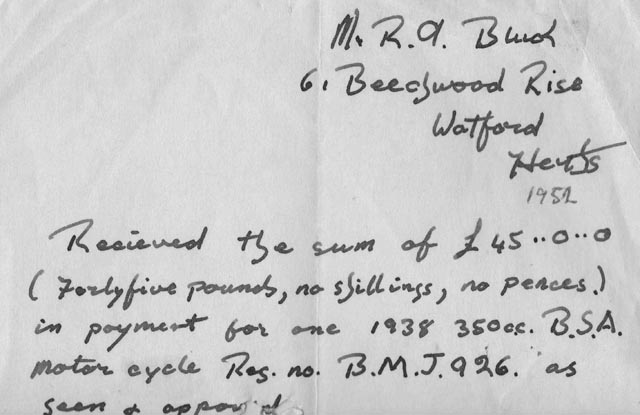
With thanks to Denis Carrington for this contribution.